Hear more about this story and how it developed on the Peninsula Report radio podcast.

East Palo Alto police are reaching out to play with city residents in hopes that bike rides, flag football and other outdoor activities can help curb violence and decrease chronic diseases.
Since July, the police department has joined two communities in establishing Fitness Improvement Training (FIT) Zones at local parks, where residents play various sports with officers and receive health information. The communities were selected because they had the highest number of gunshots in East Palo Alto as documented by ShotSpotter, a gunshot-location system, said Acting Police Chief Federico Rocha.
Police met with residents in advance to decide what activities to include in each FIT Zone and where the weekly events should be held, Rocha said.
One of the FIT Zones is from 5:30 to 6:30 p.m. each Wednesday at Jack Farrell Park; the other is at the same time on Thursdays at Martin Luther King Jr. Park. The activities range from team sports, such as volleyball and flag football, to bike rides led by police officers. The project also provides 30 bicycles for kids to use during the events, as well as helmets. Health educators from the Ravenswood Family Health Center staff the events.
FIT Zones are being promoted as more than a take-back-the-streets initiative. Rocha said police do hope to engage families to make parks safer, but they also want to establish a habit of healthy outdoor activities to fight chronic diseases.
While residents of San Mateo County have an average age at death of 75, East Palo Alto residents have an average age at death of 61.8 years, according to statistics compiled by Get Healthy San Mateo County.
Heart disease, diabetes and other chronic diseases cause a large portion of premature deaths, says the Centers for Disease Control and Prevention (CDC). For many affluent populations, the risk for these diseases is decreasing. But areas with large minority groups or where significant portions of residents fight poverty, the diseases continue to affect a disproportionate number of people, the CDC found.
East Palo Alto hosts a diverse population, with the most recent U.S. Census providing this breakdown: 64.5 percent Hispanic, 7.5 percent Pacific Islander and 16.7 percent black. Thirty-five percent of city residents over 25 did not graduate from high school and per capita income was $17,942, according to 2010 Census data.
The CDC recommends a healthy diet, no smoking and regular exercise to combat heart disease, diabetes and several other chronic diseases.
For many, the easiest form of exercise is walking. However, simply going outside for a walk is difficult for some in East Palo Alto. “One of the reasons they don’t go out, they don’t walk, children don’t play in front of their houses, is fear of gun shots,” said Luisa Buada, chief executive officer of the Ravenswood Family Health Center, a partner in the FIT Zone project.
Health “navigators” from the center give interactive presentations about diet, diabetes and other health topics at FIT Zone events. Then they stay to answer residents’ questions. The navigators live or have lived in the community and are well known to residents.
East Palo Alto tried several projects in the past to create a healthier, safer environment. According to Rocha, the FIT Zone program is unique in that the department is treating “violence as a disease.”
At an Oct. 2 City Council meeting, Mayor Laura Martinez, who had participated in one of the prior week’s FIT Zones, offered praised for the program. One council member, however, questioned whether police should be involved in an effort that focuses on fitness. “I’ve been living a long time and I’ve never seen a health program to reduce crime,” Councilman A. Peter Evans said. “Health make(s) people healthy to go out and commit crime. Its unfortunate that the police department is now looking like they are replacing the recreation department.”
The project began when the police department received a one-year “mini-grant” from The California Endowment — a private, statewide health foundation — to reduce crime through public health strategies. The grant of just under $200,000 ends in February, Rocha said.
It took five months from receiving the grant to starting the first FIT Zone event in July. The effort to fully include residents in the decision-making process, as well as implementing a health and safety survey, led to the delay, Rocha said. The police department asked for a grant extension to provide funding for a full year, but even “one year is pretty short” for large-scale behavior change, he said.
The California Endowment tends to adopt communities, and the FIT Zones project may lead to further funds entering the community, said Buada of the Ravenswood Family Health Center. Calls to the endowment for comment were not returned. According to the organization’s website, it funds projects that aim to improve community health.
At the East Palo Alto council meeting, officials seemed to have varying objectives for the project: to improve health, to lower crime, to better use the parks. Council Member Carlos Romero tried to narrow it down, “The purpose of the grant is to address the issues around criminality and violence. … What do we do in the end to figure out if this worked?”
The police department will compare the number of gunshots fired from before and after the project, as well as residents’ health and safety responses before and after, Rocha said. He added, “We don’t want it to be that they only come out in the neighborhood when we are around.”
[youtube]BBImRbEEVT0[/youtube]
